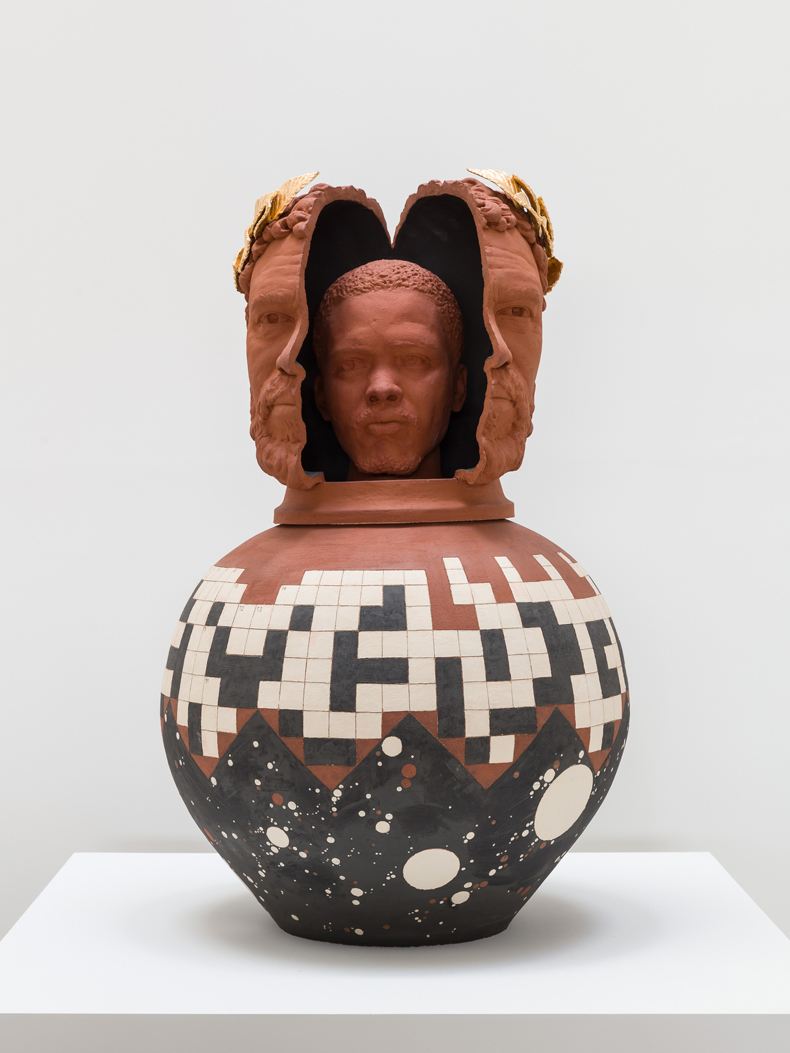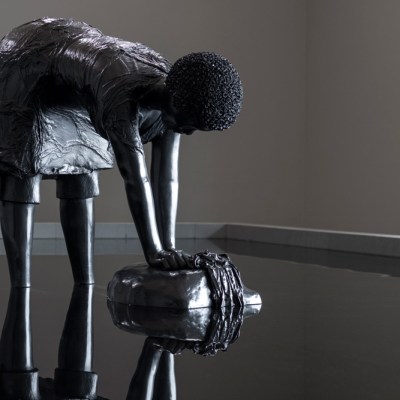In 2014 the Bahamian-born conceptual artist Tavares Strachan began working with SpaceX, the aerospace company founded and run by Elon Musk, to send a 24-carat canopic jar into orbit in honour of Robert Henry Lawrence Jr, the first African American astronaut. Lawrence died in a jet crash in 1967 before getting a chance to enter outer space. The artwork, which Strachan named ENOCH after the biblical figure who did ‘not see death’, offered the astronaut a maiden voyage: the jar orbited the earth from 2018 until 2021.
A reproduction of Strachan’s sculpture is on display in ‘There Is Light Somewhere’, an exhibition of the artist’s work at the Hayward Gallery in London. The jar epitomises a certain notion of art as monument, a recurring feature of Strachan’s oeuvre. At the core of this tendency lies a thorny question: do such works signify the powerful bending their knee to the marginalised? Or do they simply lend legitimacy to notions of art that might be better consigned to a previous century?
Across the three floors dedicated to ‘There Is Light Somewhere’, a myriad of answers present themselves. On the second floor, outside and overlooking the river Thames and London’s South Bank, is Black Star (2024), a reproduction of a steam ship embossed with the logo of the Black Star Line – the shipping line created by the Jamaican activist Marcus Garvey, who rallied African Americans to support and become part-owners of a shipping company that facilitated Black-run trade between Africa and America. Garvey’s brand of pan-Africanism failed to achieve its aims but the symbols with which it is associated retain a romantic aura – something Strachan tries to capture on the Hayward’s flooded sculpture terrace.
Installation view of Black Star (2024) by Tavares Strachan outside the Hayward Gallery. Photo: Mark Blower; courtesy the artist and Hayward Gallery; © the artist

If the scale of the work here and elsewhere in the show is inversely proportional to its conceptual boldness – demanding recognition of historic cultural and political movements is hardly a new gambit in art – it isn’t the only order of the day. A series of collages that combine metallic materials, print and fabric are the most visually interesting works in the exhibition, and raise some provocative questions. Every Tongue Shall Confess (2023) features a large image of a young Queen Elizabeth II dressed in full imperial garb, her crown bearing a fragment of the Cullinan Diamond, mined in South Africa under British rule. At the top of the canvas are three reproductions of the front cover of an issue of the African American magazine Jet from 1952, the year in which Elizabeth II ascended the throne. On these covers, wearing a British staff officer’s uniform, is Haile Selassie, the emperor of Ethiopia from 1930–74 and the subject of a feature article in the magazine titled ‘Africa’s Last King’. How we ought to relate to this image of Selassie is left ambiguous. In the Jet magazine article, available online but not as part of the exhibition, the Ethiopian emperor is mocked for his anachronistic imperial pretensions and cosy relationship with the British. The collage draws an equivalence between British and African royalty, but whether this elevates the latter or condemns both is left up to the viewer.
Every Tongue Shall Confess (2019), Tavares Strachan. Photo: Miho Suzuki; courtesy and © the artist

In interviews and discussions, Strachan has spoken about the way historical and cultural narratives can take hold, and how they promote some figures while excluding others. Subverting these dominant narratives is a project Strachan undertakes with variable results. Much of the artist’s work – for instance, a sculpture from his Inner Elder series (2023) in which a bust of the Libyan Roman emperor Septimius Severus has been opened up to reveal a likeness of South African socialist and anti-Apartheid hero Steve Biko – simplifies complex narratives about racial uplift in two very different eras and places, stripping them of their context. Somehow, Strachan has managed to invest the politics of decolonisation with the trappings of imperial nostalgia.
Installation view of Inner Elder (Biko as Septimius Severus) (2023) by Tavares Strachan at the Hayward Gallery. Photo: Mark Blower; courtesy the artist and Hayward Gallery; © the artist

At his best, the artist plays on several senses at once to test the viewer’s assumptions. His Distant Relatives series (2020) comprises a row of famous African American figures such as James Baldwin. Their white plaster busts have been placed behind African masks, inverting – intentionally or not, it isn’t clear – the title of Frantz Fanon’s classic study of the psychological effects of colonialism, Black Skin, White Masks (1952). But walking toward the sculpture, the viewer might find their feet clipped by the scraggy ground that Strachan has had installed on the second floor of the Hayward. Its red colour and texture recall African soil and suggest we should be viewing these images from a drastically different perspective. Seen from outside the West, perhaps notions of racial authenticity and coherence are too complex to be understood in terms of black and white.
Installation view of the Distant Relatives series (2020) by Tavares Strachan at the Hayward Gallery. Photo: Mark Blower; courtesy the artist and Hayward Gallery; © the artist

Still, this may be a generous interpretation of Strachan’s work and intentions. What ultimately limits the scope of his work is its obsessive concern with the construction of monuments. Even as he presents himself as offering a critique of certain ideas and ways of thinking, much of what he produces – busts, statues, monuments to heroes – hews to simplistic and conservative notions about what art can be.
Perhaps ENOCH is symbolic, but not in a way that its creator intended. Given its materials and the labour involved in making it, the canopic jar very much seems like a luxury item. But reading the wall text explaining the sculpture’s backstory and looking at the glittering object, it is hard to avoid the sense that we are not being invited to consider an alternative way of thinking about our collective history but instead to admire the artist’s own proximity to money and power, and the resulting ability to create his own monuments.
Installation view of Ruin of a Giant (King Tubby) (2024) by Tavares Strachan at the Hayward Gallery. Photo: Mark Blower; courtesy the artist and Hayward Gallery; © the artist

‘Tavares Strachan: There Is Light Somewhere’ is at the Hayward Gallery, London, until 1 September.



